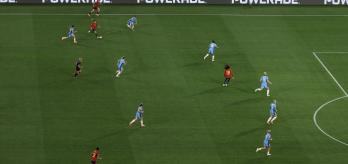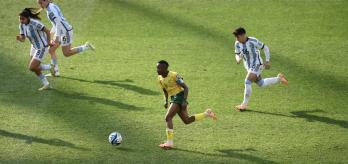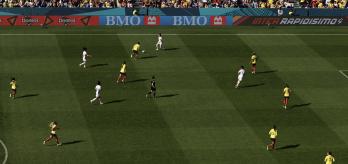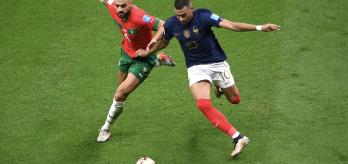Key points
-
Central and defensive midfielders amassed the most total distance and centre-backs covered the least ground at the FIFA Women’s World Cup 2023™.
-
A novel finding of this analysis was that centre-forwards now cover the most sprint distance of any position during match play.
-
Sprinting trends across the last three FIFA Women’s World Cup™ tournaments demonstrate that centre-forwards and centre-backs have evolved compared to other positions.
Benchmarking specialist positions
A common finding across studies exploring the match demands placed on elite female players is that their physicality is highly dependent upon their playing position.1-4 Some studies use broad categories to define positions such as defenders, midfielders and forwards, while others have assigned up to four or five different positional roles to female players.2-5 Recent findings have demonstrated that using specialised outfield roles to map the match demands of elite men’s football resulted in highly distinguishable movement characteristics compared to broad categories.6-7
However, no research to date has partitioned female players in international tournaments into highly specialised outfield positions. Redressing this shortcoming is highly relevant to the women’s football community, especially given the up-to-date nature of the data from the FIFA Women’s World Cup Australia & New Zealand 2023™. Thus, this analysis is the first to comprehensively break female international players down into the eight highly specialised outfield positions below:
-
Centre-back (CB)
-
Wide defender (WD)
-
Defensive midfielder (DM)
-
Central midfielder (CM)
-
Attacking midfielder (AM)
-
Wide midfielder (WM)
-
Wide forward (WF)
-
Centre-forward (CF)
It is worth noting that the data provider, rather than the author, assigned the specialised positional roles above. These were based on the tactical systems adopted at the start of games and the same players may have been assigned different roles across various matches. Although the author agreed with most role assignments by the data provider some disagreement was evident at times.
Central midfielders still cover the most ground overall
Basic physical benchmarking across positions enables practitioners to monitor whether modern tactics are modifying certain roles in the team. Figure 1 shows that central and defensive midfielders accumulated the most total distance – around 15% more than centre-backs, who covered the least ground overall – at the FIFA Women’s World Cup 2023™. Similar positional findings for total distance were found for both Canada 2015 and France 2019.8 Therefore, this trend is stable at the highest level of women’s international football.
Midfielders are renowned for their all-round work rate and, in keeping with this idea, they covered the most ground during FIFA Women’s World Cup 2023 games. To cite a couple of standout examples, Spain’s Teresa Abelleira and Zambia’s Ireen Lungu covered 12.3-13.3km during selected games. This set the upper benchmark for contemporary international female midfielders (Figure 1). This finding is not surprising, as midfielders have to be highly active during all phases of play. In-possession and out-of-possession activities such as moving to receive, progressing up the pitch, defensive recoveries and pressing require those who occupy this position to be particularly dynamic. The minimum requirement for a modern female midfielder is around 8.7km, which is one of the highest such baselines across all positions.
Meanwhile, centre-backs tend to have a more sporadic activity profile, with more of their activity occurring out of possession, hence the lower total distance covered. However, centre-backs are acutely influenced by the opposition’s attacking quality.9 For example, the Philippines’ Jessika Cowart covered around 11.6km against Switzerland: this was the highest total distance for this position at the whole competition. In that specific match, Switzerland’s attacking dominance resulted in their highest figures for movements in behind and final-third activity of their tournament. To nullify this, the Philippines’ defensive unit had to respond with their greatest number of applied pressures of their three games at the FIFA Women’s World Cup 2023, which explains Cowart’s physical output. On the contrary, Canada centre-back Kadeisha Buchanan covered only 7.8km against Nigeria, which was the lowest total distance at the tournament. Buchanan did not need to defend much in that game as her team were consistently on the front foot, as evidenced by Canada registering their highest progression and final-third activity counts of their tournament.
Centre-forwards are now the sprint leaders
A real focal point for practitioners is usually the activities performed at high intensity (>19.0km/h), due to their key role in game-changing moments. Figure 2 highlights that wide midfielders and wide forwards covered around 42-89% more ground at such speeds than centre-backs and central/defensive midfielders. The average high-intensity game distance for both of these wide roles was around 0.8km. However, at the upper level, Zambia’s Racheal Kundananji and Haiti’s Roseline Éloissaint averaged around 1.4-1.6km, underscoring just how demanding these wide attacking roles are in the modern women’s game. This finding could be linked to the superior physical characteristics of wide operators as opposed to central players.
However, this is very nuanced and the causality of this finding is not straightforward. For example, the increased high-intensity distance covered by wide players could also be related to some extent to the extra space afforded to them along the flanks, which enables them to accelerate and thus reach higher speeds when tactically required. Moreover, wide players may be more active at high intensity due to modern tactics, with teams now commonly employing compact mid-blocks that prompt the opposition to use the space along the flanks to create chances from crosses.6
On the other hand, central players operate in areas of the pitch that tend to be more congested in the modern game, which limits their ability to accelerate into space. This is especially true if they are required to maintain tactical discipline and hold a position in dense central areas for long periods. Such factors may have resulted in players with central roles completing much lower amounts of high-intensity running (between 0.4km and 0.6km per match) during the competition in Australia & New Zealand.
An extremely novel finding of this analysis is that centre-forwards now cover the most sprint distance during women’s international match play. For instance, Figure 3 shows that centre-forwards sprinted an average of 263m per game at the tournament. This was 7-8% higher than their attacking counterparts, such as attacking midfielders, wide midfielders and wide forwards. Interestingly, wide attacking players covered similar or either more sprinting than centre-forwards at Canada 2015 and France 2019. A key role of a centre-forward is to move rapidly to receive the ball in attacking areas, particularly making runs into the space in behind the opposition defence.7 Tellingly, centre-forwards amassed around 45-80% more movements in behind than players in other attacking positions during this tournament.
This was often coupled with defending intensely from the front via pressing actions. Both of these factors could go some way towards explaining the evolution observed in centre-forwards’ sprinting output. Indeed, centre-forwards covered a staggering 39-163% more sprinting than positions that are more defensive (e.g. centre-backs, wide defenders, defensive and central midfielders) at the FIFA Women’s World Cup 2023. This clearly highlights the need for practitioners to develop training drills that require players to sprint in a position-specific way, taking into account these evolving trends.
Figure 4 reveals that the top speeds attained in games were fastest for attacking midfielders, wide midfielders, wide forwards and centre-forwards (29.1-29.4km/h), while defensive and central midfielders (28.0-28.1km/h) had the lowest top speeds. The top ten speeds attained at the tournament are also highlighted, with centre-forwards (30%), wide forwards (20%) and attacking midfielders (20%) accounting for 70% of these efforts. The remaining 30% came from players in defensive positions. This attests to the importance of speed development across all positions in women’s international football, especially for attacking players. Please note that top speed accuracy could be impacted by the limited sampling frequency of the optical tracking system used, thus caution is needed when interpreting these trends.
Position-specific quadrant plot and distribution
Using match data to create position-specific drills is of paramount importance for practitioners.10 Ideally these drills should provide an overload stimulus that taxes the relevant physical attributes to enable players to fulfil their positional duties across the 90+ minutes (volume) and particularly during intensified match play periods (intensity). The match data from the FIFA Women’s World Cup 2023 was viewed from a unique perspective by correlating these two distinct dimensions using quadrant plots. By plotting the total distance against that covered at high intensity (>19.0km/h), Figure 5 allows practitioners to determine which positions were more volume-based and which were more intensity-based. The distribution of player observations in each quadrant was also added to provide context regarding positional variation.
As expected, the majority of centre-backs clearly fall into the lower-left quadrant (87%). This demonstrates that centre-backs exhibited both low volume and intensity characteristics. Wide defenders primarily occupied the lower-left quadrant (42%), but some excursion into the upper-left (21%) and upper right quadrants (23%) also occurred. This suggests that wide defenders typically covered a low volume of distance at the tournament, but intensity varied somewhat. Central and defensive midfielder’s physical performances emulate each other with most falling within the lower-right quadrant (44-50%). This implies that a prerequisite of both positions was to cover considerable distances in total, but high-intensity running varied for certain individuals, as numerous players also ventured into the upper-right (17-21%) and lower-left quadrants (31-32%).
Wide midfielders, wide forwards and attacking midfielders mainly occupy the upper-right quadrant (40-61%), revealing both high volume and intensity qualities. Nevertheless, substantial individual variation existed for these roles, as some excursions into the upper-left quadrant also occurred (18-32%). Finally, centre-forwards were the position that fluctuated the most, as no clear majority quadrant was apparent. This may indicate the existence of various centre-forwards archetypes within the sample (e.g., false 9s, supporting forwards, target forwards, out-and-out strikers, etc).
Although a practitioner could potentially extrapolate from such trends, the degree of physical preparation needed for these positions, caution is still warranted given the extensive variation that existed across all positional profiles. This is especially evident for centre-forwards, as these players resided fairly equally in all quadrants. Given such a data spread, conditioning practices should always be in alignment with the age and capabilities of the players in these roles, in addition to the playing style adopted by each team.
Position-specific sprinting across three fifa women’s world cup™ editions
Figure 6 plots position-specific sprinting across the last three editions of the FIFA Women’s World Cup. This is the largest sample of international female players ever analysed and includes more than 2000 player observations. Despite Zone 5 having been identical across the three competitions, the optical tracking systems differed. For instance, the STATS LLC system was used in 2015 and 2019, while TRACAB CH was employed in 2023. As it would be challenging to compare positions between tournaments from 2015, 2019 and 2023 editions due to the tracking technology differences, a within positional analysis of selected positions at the high and low end of the sprinting continuum was conducted. To further aid this within positional comparison, the author also calculated relative rather than absolute measures (e.g. Zone 5 distance as a percentage of total distance instead of just Zone 5 distance as metres). Selected positions were combined in Figure 6 as the 2015 and 2019 data sets did not spilt data into eight outfield roles (e.g. defensive/central midfielders).
Figure 6 highlights a clear trend at the low end of the sprinting continuum within each competition, as centre-backs and central/defensive midfielders covered the lowest sprint distance as a proportion of total distance. Given the similarities for these positions across the three tournaments, one could potentially gain insights into evolutionary changes by comparing both positions in each edition. At Canada 2015, centre-backs performed 11% more sprinting than central/defensive midfielders. However, at France 2019 in addition to at Australia & New Zealand 2023, centre-backs performed 21-26% more sprinting than central/defensive midfielders.
Moreover, another obvious trend at the high end of the sprinting continuum within each competition was that centre-forwards and wide midfielders/wide forwards covered the most sprinting distance as a proportion of total distance. At Canada 2015, there was negligible difference between these offensive positions. However, at France 2019, centre-forwards sprinted 11% less than wide midfielders/wide forwards but at Australia & New Zealand 2023 this trend reversed as centre-forwards covered 11% more sprinting than wide midfielders/wide forwards.
Accordingly, the sprint profiles of these two positional adversaries could be inextricably connected (e.g. centre-backs and centre-forwards). Such interdependency appears logical: as centre-forwards increasingly attack space or run with the ball, it follows that centre-backs are required to react through various runs to press, cover or track back. Although the author has been overly cautious in this analysis by only observing within-competition positional trends for relative measures, the reader should still be cognisant of the numerous caveats associated with comparing data from different optical tracking systems and view the trends with some caution.
References
-
Bradley PS & Vescovi J. Velocity thresholds for women’s soccer matches: sex specificity dictates high-speed running and sprinting thresholds – Female Athletes in Motion (FAiM). International Journal of Sports Physiology and Performance. 2015, 10(1): 112-116.
-
Mohr M, Krustrup P, Andersson H, Kirkendal D & Bangsbo J. Match activities of elite women soccer players at different performance levels. Journal of Strength and Conditioning Research. 2008, 22(2): 341-349.
-
Datson N, Drust B, Weston M, Jarman IH, Lisboa PJ & Gregson W. Match Physical Performance of Elite Female Soccer Players During International Competition. Journal of Strength and Conditioning Research. 2017, 31(9): 2379-2387.
-
Bradley PS, Dellal A, Mohr M, Castellano J & Wilkie A. Gender differences in match performance characteristics of soccer players competing in the UEFA Champions League. Human Movement Science. 2014, 33: 159-171.
-
Nakamura FY, Pereira LA, Loturco I, Rosseti M, Moura FA & Bradley PS. Repeated-Sprint Sequences During Female Soccer Matches Using Fixed and Individual Speed Thresholds. Journal of Strength and Conditioning Research. 2017, 31(7): 1802-1810.
-
Bradley P. ‘Setting the Benchmark’ Part 1: The Contextualised Physical Demands of Positional Roles in the FIFA World Cup Qatar 2022. Biology of Sport. 2024, 41(1): 261-270.
-
Ju W, Doran D, Hawkins R, Evans M, Laws A & Bradley PS. Contextualised high-intensity running profiles of elite football players with reference to general and specialised tactical roles. Biology of Sport. 2023, 40(1): 291-301.
-
FIFA, Physical Analysis of the FIFA Women’s World Cup France 2019™, 2020. Available at: img.fifa.com/image/upload/zijqly4oednqa5gffgaz.pdf. Accessed January 2024.
-
Bradley PS. The Premier League Way: Contextualising the Demands of the World’s Most Intense League. 2022, Amazon, United Kingdom.
-
Ade JD, Drust B, Morgan O & Bradley PS. Physiological characteristics and acute fatigue associated with position-specific speed endurance soccer drills: production vs maintenance training. Science and Medicine in Football. 2020, 5(1): 6-17.













